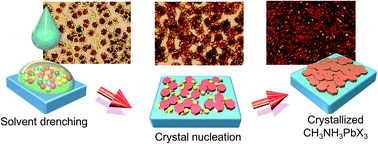The mechanism of toluene-assisted crystallization of organic–inorganic perovskites for highly efficient solar cells†
Abstract
We investigate the influence of solvent drenching in hybrid organic–inorganic perovskite (CH3NH3PbX) crystallization process with a non-solvent, toluene, during film fabrication process. We use three different precursor compositions, CH3NH3I (MAI):PbI2, 3MAI:PbI2 and 3MAI:PbCl2 to unravel the crystallization mechanism with toluene drenching. The mixed halide precursor (3MAI:PbCl2) results in the highest quality films with the toluene treatment, including high surface coverage, large grains, long PL lifetimes and high photoluminescence quantum efficiency (PLQE). The neat halide-based precursors (MAI:PbI2 and 3MAI:PbI2) with the treatment have increased photo-physical properties (PL lifetime and PLQE) and a surface coverage, but slightly decrease grain size in the film, while the 3MAI:PbI2 precursor has still formed numerous pinholes in the film. Mechanistically, we visually observe that the toluene drenching accelerates the nucleation at early stage of crystallization in 3MAI:PbCl2 precursor. X-ray diffraction pattern in this stage confirms the formation of both MAPbI3 and MAPbCl3, nucleation. During the crystallization process MAPbCl3 is transformed into MAPbI3 phase by the anion exchange. Toluene treatment strongly affects the ratio of MAPbI3 and MAPbCl3, nucleation and hence plays a critical role in deciding the final film morphology, their optoelectronic properties and hence their device performances.


 Please wait while we load your content...
Please wait while we load your content...